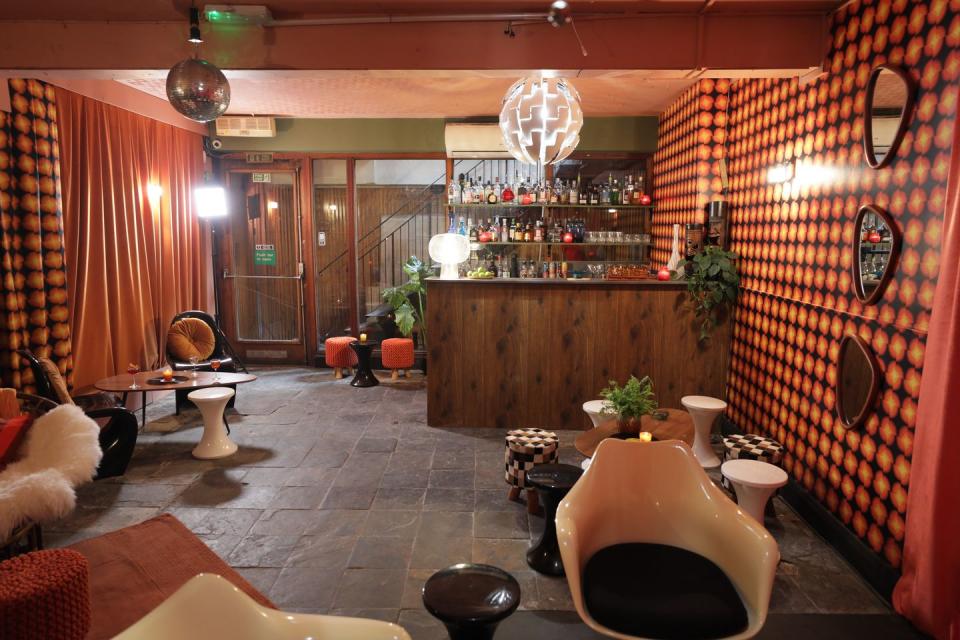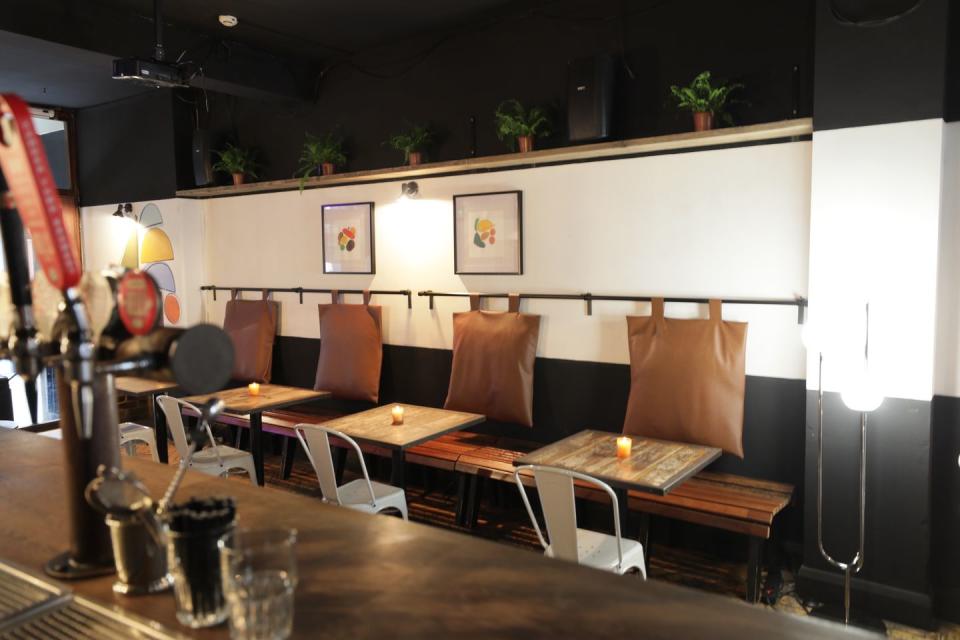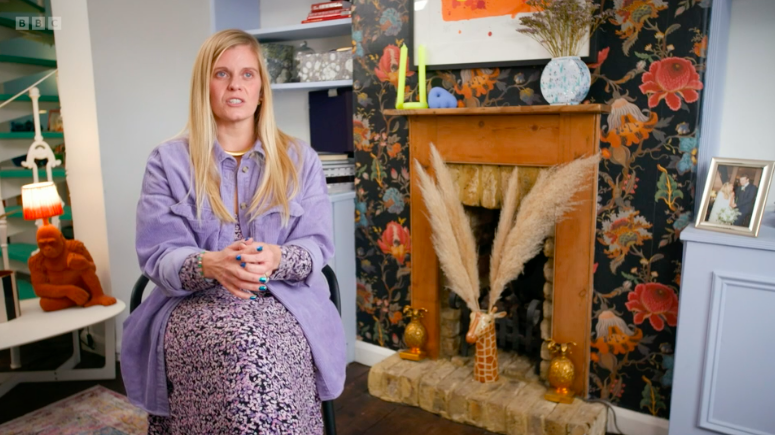Interior Design Masters runner-up Amy: 'When I was accepted on the show, I genuinely thought it was a prank'

Everyone loved Amy, 39, a print-maker and illustrator originally from Ayrshire in Scotland, now living with her husband in south-west London. She came second to winner Banjo on series three of Interior Design Masters, but as her self-assurance and personal style took the leap from surface design to full-scale renovations, it was always going to be a close-run thing.
The judges – and viewers – were delighted to see her develop in confidence. By the end of the series Amy was doing things she never imagined herself capable of, such as demolishing an entire bar in the final.
With the brief of turning a more-then-slightly tacky basement 'Tiki bar', plus an upstairs bar/café into a welcoming Soho destination, she never faltered, creating two bold schemes which showcased her love of pattern, design and colour in quite different, but subtly connected ways.
House Beautiful caught up with Amy after the final and she told us about coming back down to earth – and shared the exciting news about the launch of her own brand new home textiles business.
Where are you now?
At home in south-west London, near Barnes.
Where did you catch the final show?
In the bar in Soho with the others. I hadn't seen a lot of the production team since filming finished, so it was nice to catch up with everybody.

What did you think when you first saw the bar? Did your heart sink?
On the top floor, my initial thought was that there was nothing there. It was almost like a moody dive bar. The big challenge was that it was already well-loved by Londoners and had been here for years. I thought, how can I make my mark here?
Downstairs, it was obviously a different story. I think a lot of it had been installed by a handyman years ago. I didn't know what was behind anything. Someone would say 'oh yes, that's made of copper' and we'd look behind it and it wouldn't be at all.


The judges hinted that they might like to have seen a little more design connection between upstairs and downstairs. Did this bother you?
I went in the evening to see how it flowed before I started, to see the space, movement and flow throughout the bar. But these were two quite distinct spaces. They weren't connected before and when I started to think of the schemes, I didn't think of them together, but separate.
Downstairs it was a crazy Tiki bar, upstairs it was more of an open space. When I first saw it, it was quite intimidating, but I wanted to turn it into somewhere where you would feel fine to go in for a coffee. Especially as a woman, I think. Sometimes places can be a bit daunting, especially if they're quite dark. You don't know who you are going to meet or even if they will serve you a drink. I mean, they sold coffee here, but I don't think anyone ever asked for one.
The crisp white and black really opened up this space. Fran did some great murals as well, and the colours tied in a little bit with downstairs – it was subtle.

There was a sense of creative freedom too, treating them as separate spaces. We'd done the lodges the week before and I worked really hard to make sure that the inside and outside space flowed together successfully.
That crazy wallpaper downstairs though? Wasn't it a bit of risk?
Well, with my background previously in print and colour, it was quite nice to have got to that point myself where I felt I could use it to good effect. The owner liked the idea of a Seventies scheme. I loved the orange graphic-patterned wallpaper. Looking at it feels like you've had one too many piña coladas.

If people are worried about using a strong wallpaper at home, I'd say just go for it. If it doesn't work, you've only wasted £100 on a roll of wallpaper. And I would say that sometimes a strong wallpaper works better in a smaller room. At home, I've got the tiniest bathroom in the world, I think, but the patterned wallpaper adds so much impact.
What was your favourite scheme of all?
I have to say that it was the waterside retreat last week. I really felt like my confidence was developing by this point. It all came together so easily. I love that I took risks I perhaps wouldn't have taken earlier in the series. And also, I put quite a lot of myself in there too. I thought about how I would have liked it to look and feel if I'd been going there with my own friends.
How do you feel now that the show is over?
I never ever thought that I would get so far. When I was accepted on the show I genuinely thought it was a prank. When we started, I thought everyone else were such big amazing characters. But as more and more people went out, although I was sad to see them go – because we were all really good mates – it did give me confidence in a funny way. I thought, well I'm still here for a reason. I never thought I would be brave enough to do demolition, but at that point you just throw caution to the wind. You know you're in the final and there's nowhere to else to go, so I just went for it.

If would-be designers are worried about applying to the show, what should they tell themselves?
I think just apply, apply. I didn't think for a minute that I would have the talent to even apply, never mind get down to the final 10 selected for the show. In terms of being a contestant, I think it's probably about setting up a bit of a structure with the rest of your life. You have to be on top of everything at home, at work, do your research on what you're going to be doing and get prepared for being away.
And I'd say, don't live from week to week. Assume for your own mental health that you'll be in it until the end. It is very gruelling, physically especially, but it's such an amazing experience and they do brief you and warn you first.

In last night’s final, you mentioned your challenging fertility journey. Many viewers would have found this very moving. Would you like to share your thoughts on this highly-emotive subject?
I don't think that the issue of fertility is talked about in any great depth and made public enough. Many women, and men, for that matter, suffer in silence if they're going through difficulties. I have a bad history with recurrent miscarriage and also failed IVF. It's been going on for four years for me now. I can get pregnant, but when I do I miscarry. It's been discovered that I have a problem with my blood, it's a clotting disorder, which is a contributory factor to recurrent miscarriage. It requires daily injections of blood thinner to keep a pregnancy going. There are a couple of other issues too, but this is the main thing. I'm very much still in the process.
The one thing to be positive about is that it's not something I’ve done wrong. It’s not about getting too stressed, or eating the wrong kind of food or anything like that, it's genetically-caused.
I was getting very worn down with it all before I took part in the show. I did take time to see friends and had one or two hobbies, but I needed something different in my life, I think. This feels almost like an indulgence, yes, but it has given me a complete refresh and confidence I didn't know I had.

What next for you Amy?
I'm using the career that I have in fashion to launch a range of textiles, including napkins and table mats this week. I do everything myself. But there's so much technical stuff, my husband, Freddy, is helping me. He works in PR for brands such as Facebook and Spotify, organising events.
• Follow Amy on Instagram @amydavies_design.
Follow House Beautiful on Instagram.
You Might Also Like



